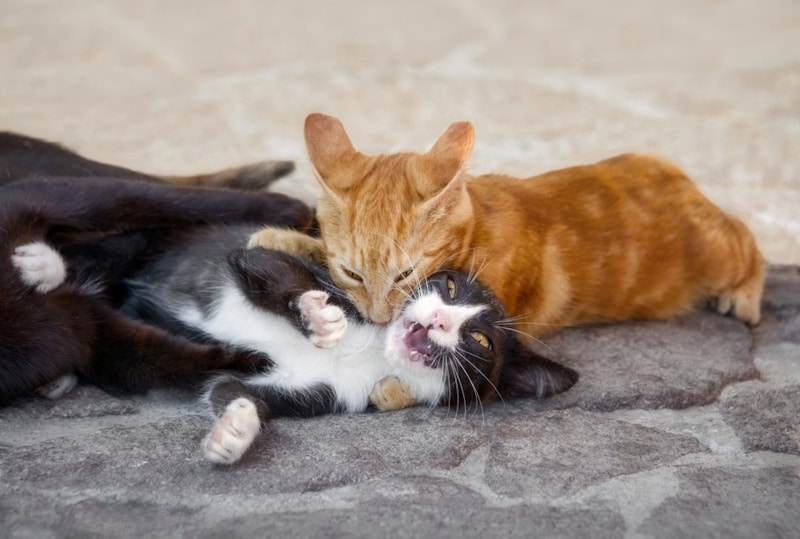[ad_1]
If you have more than one cat, you may have noticed that cats have a tendency to bite each other on the neck. Sometimes these bites are on the scruff of the neck, while other times they happen in the throat area. There are actually a few reasons that your cats might be biting each other on the neck, so let’s jump into a few of the reasons for this feline behavior.

5 Reasons Why Cats Bite Each Other’s Necks
1. Dominance
In nature, cats are usually solitary animals, but domestic cats living in households often seek to develop a hierarchical structure within the home if there are multiple cats. In order to prove themselves at the top of the hierarchy, a cat has to prove its dominance. Biting other cats, particularly on the back of the neck, is part of this dominance assertion. This type of biting typically doesn’t break the skin.

2. Mating
If you’ve ever seen cats mating, then you know that it’s not something that appears gentle. Part of the mating ritual involves the male cat biting the female cat on the back of the neck. It’s likely that this is done to show dominance and to help keep the female in place. This biting is usually not done aggressively enough to break the skin.
3. Play
Some cats love to roughhouse, and biting and scratching are simply part of the game. You may see one of your cats pounce on the other’s back and bite them on the back of the neck, but during play, cats are more likely to bite the front part of the neck.
For cats, playing is a form of practicing their hunting skills, and cats may bite their prey on the throat to kill them. If done during play, this biting should not hurt the cat that is being bitten and shouldn’t break the skin, although an over-exuberant cat may unintentionally bite the other cat too hard.

4. Aggression
Biting the neck as a form of aggression is a step above using biting to assert dominance. If a cat is showing aggression, they are unlikely to only bite the neck, and there is a good chance that they’ll break the skin with both teeth and claws. If your cats are being rough with each other and either of them is hissing, yowling, or showing signs of fear, then it’s time to break things up so everyone can cool off.
5. Grooming
Mother cats bite the backs of their kittens’ necks to carry them, and you may also spot a queen biting the back of the neck of a kitten that isn’t cooperating for a grooming session. This is partly an assertion of dominance—almost an, “I’m your mother and you’ll listen to me,” kind of behavior. It also serves as a reminder like, “I’m trying to groom you, hold still!” This behavior is not specific to mother cats, so you may spot two adult cats doing it to each other. This type of biting is typically very gentle.

In Conclusion
Cats naturally bite each other on the neck for multiple reasons, and most of them are benign. It’s important for you to keep an eye on your cats if you see biting occurring, though. Sometimes, games can get out of hand and turn aggressive. In some cases, you may need to help your cats as they establish a hierarchy if there’s a new cat in the home. This establishment of dominance can take time and should be monitored closely to make sure your cats aren’t hurting each other.
Featured Image Credit: Katho Menden, Shutterstock
[ad_2]
Source link
